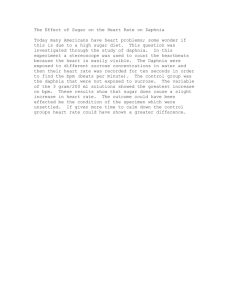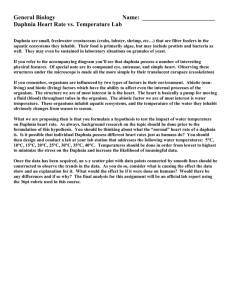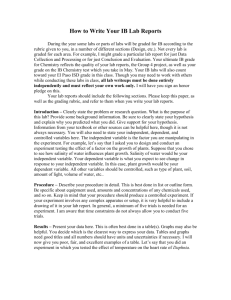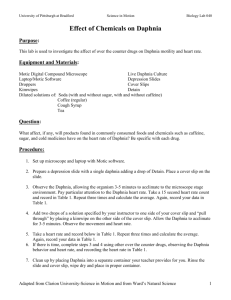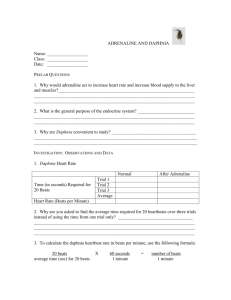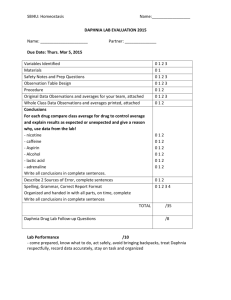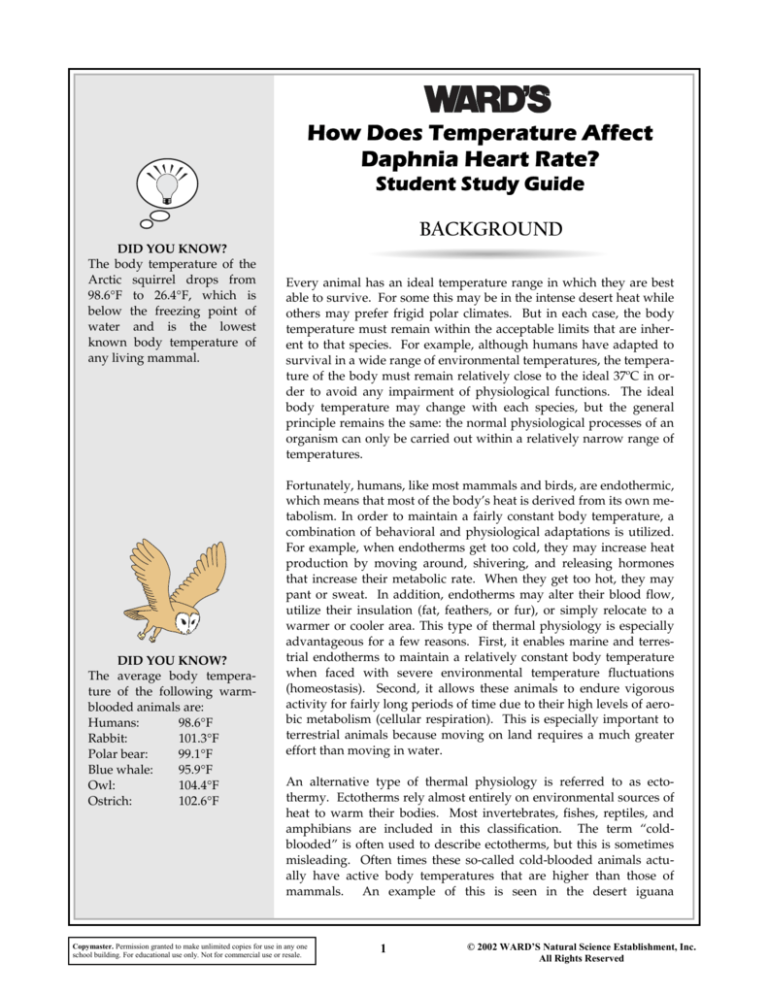
TM
How Does Temperature Affect
Daphnia Heart Rate?
Student Study Guide
DID YOU KNOW?
The body temperature of the
Arctic squirrel drops from
98.6°F to 26.4°F, which is
below the freezing point of
water and is the lowest
known body temperature of
any living mammal.
DID YOU KNOW?
The average body temperature of the following warmblooded animals are:
Humans:
98.6°F
Rabbit:
101.3°F
Polar bear:
99.1°F
Blue whale:
95.9°F
Owl:
104.4°F
Ostrich:
102.6°F
BACKGROUND
Every animal has an ideal temperature range in which they are best
able to survive. For some this may be in the intense desert heat while
others may prefer frigid polar climates. But in each case, the body
temperature must remain within the acceptable limits that are inherent to that species. For example, although humans have adapted to
survival in a wide range of environmental temperatures, the temperature of the body must remain relatively close to the ideal 37ºC in order to avoid any impairment of physiological functions. The ideal
body temperature may change with each species, but the general
principle remains the same: the normal physiological processes of an
organism can only be carried out within a relatively narrow range of
temperatures.
Fortunately, humans, like most mammals and birds, are endothermic,
which means that most of the body’s heat is derived from its own metabolism. In order to maintain a fairly constant body temperature, a
combination of behavioral and physiological adaptations is utilized.
For example, when endotherms get too cold, they may increase heat
production by moving around, shivering, and releasing hormones
that increase their metabolic rate. When they get too hot, they may
pant or sweat. In addition, endotherms may alter their blood flow,
utilize their insulation (fat, feathers, or fur), or simply relocate to a
warmer or cooler area. This type of thermal physiology is especially
advantageous for a few reasons. First, it enables marine and terrestrial endotherms to maintain a relatively constant body temperature
when faced with severe environmental temperature fluctuations
(homeostasis). Second, it allows these animals to endure vigorous
activity for fairly long periods of time due to their high levels of aerobic metabolism (cellular respiration). This is especially important to
terrestrial animals because moving on land requires a much greater
effort than moving in water.
An alternative type of thermal physiology is referred to as ectothermy. Ectotherms rely almost entirely on environmental sources of
heat to warm their bodies. Most invertebrates, fishes, reptiles, and
amphibians are included in this classification. The term “coldblooded” is often used to describe ectotherms, but this is sometimes
misleading. Often times these so-called cold-blooded animals actually have active body temperatures that are higher than those of
mammals. An example of this is seen in the desert iguana
Copymaster. Permission granted to make unlimited copies for use in any one
school building. For educational use only. Not for commercial use or resale.
1
© 2002 WARD’S Natural Science Establishment, Inc.
All Rights Reserved
DID YOU KNOW?
Daphnia produce most of
their young without mating.
This is known as parthenogenic reproduction.
(Dipsosaurus dorsalis), which has one of the highest preferred body
temperatures known for any vertebrate - 100º to 108º Fahrenheit!
The advantage of being an ectotherm is that very little energy is used
to maintain body temperature, since this is taken care of by the environment. For example, when a lizard’s body temperature is cool, it
will sit in the sun to raise its temperature back up again. When it gets
too warm, the lizard will seek shade to cool off again. In addition, ectotherms are able to produce a small amount of heat metabolically at
low rates, and use some physiological means of thermoregulation.
However, ectotherms have a bit of a disadvantage in that they are
somewhat limited as to the environments that they can inhabit.
Alaska is certainly not an ideal home for a lizard!
We can easily study an ectotherm’s rate of metabolism by examining
the water flea, Daphnia magna. Daphnia are of great importance in the
aquatic food chain and are a principle food staple for young and
adult fish. The body of a Daphnia is translucent which makes the
beating, football-shaped heart readily visible under a microscope.
Because the heart rate is variable with water temperature, it is easy to
alter the Daphnia’s heart rate and observe the changes.
Copymaster. Permission granted to make unlimited copies for use in any one
school building. For educational use only. Not for commercial use or resale.
2
© 2002 WARD’S Natural Science Establishment, Inc.
All Rights Reserved
OBJECTIVES
•
•
•
•
Illustrate and label the main anatomical structures of a Daphnia
Alter the temperature of a Daphnia’s environment and quantify
the changes in its heart rate
Differentiate between endothermic and ectothermic animals
Understand the advantages and disadvantages of each type of
thermoregulation
MATERIALS
MATERIALS NEEDED PER GROUP
1
1
1
1
1
Microscope slide
Pipet
Petri dish
Stereomicroscope
Thermometer
Scissors
Ice
SHARED MATERIALS
DID YOU KNOW?
An adult blue whale, with a
heart the size of a small car,
has one of the slowest heart
rates...5 to 6 beats per minute.
•
•
Petroleum jelly
Daphnia culture
PROCEDURE
1.
Obtain each of the following:
50 ml room temperature water
50 ml ice water
250 ml beaker
Thermometer
Petri dish
Microscope slide
Heat protective gloves are recommended when working
with hot plates
GLOVES
2.
Place 150 ml of tap water in the beaker and allow it to boil on a
hot plate. While you wait, proceed to Step 3.
3.
Set the lid of the Petri dish aside and fill the bottom of the dish
with 25 ml of room temperature water (approximately 25°C).
4.
Place a dab of petroleum jelly in the center of a microscope slide.
Copymaster. Permission granted to make unlimited copies for use in any one
school building. For educational use only. Not for commercial use or resale.
3
© 2002 WARD’S Natural Science Establishment, Inc.
All Rights Reserved
5.
Obtain a graduated pipet and cut the pipet at the line marked
“.5”. Use this pipet to place one large Daphnia on the dab of petroleum jelly. Make sure that the Daphnia cannot swim away
and then pour off all of the extra water from the slide into the upside-down lid of the Petri dish.
6.
Dispense 25 ml of room temperature water into the Petri dish (not
the lid). Place the slide with the Daphnia in the dish, and allow it
to sit for at least one minute to equilibrate.
7.
Place the entire dish on the stage of a stereomicroscope.
8.
Look through the microscope and locate the beating heart of the
Daphnia, which sits behind the dark line of the digestive tract.
Draw what you see in the space below. Be sure to label the heart
as well as any other anatomical structures you may recognize.
9.
Practice counting the number of heart beats in a 15 second period:
Have one partner keep track of the time while the other observes.
Once the observer indicates that they are ready, the timing
should begin. Switch positions and repeat this practice. Do not
move on to the next step until both partners feel comfortable
measuring the heartbeat.
DID YOU KNOW?
A hummingbird’s heart beats
about 1,000 times per minute.
HINT
It may be helpful for the observer to count in increments
of ten and keep track of every tenth beat by counting off
with their fingers (i.e., three fingers would equal thirty
beats).
10. Take the temperature of the room temperature water in the Petri
dish and record this number in Table 1. Count the number of
times the heart beats over a period of 15 seconds and record this
data in Table 1. Repeat the count three more times and record
your results in Table 1.
Copymaster. Permission granted to make unlimited copies for use in any one
school building. For educational use only. Not for commercial use or resale.
4
© 2002 WARD’S Natural Science Establishment, Inc.
All Rights Reserved
11. Remove the slide and empty the Petri dish of the water. Fill the
dish with approximately 30 ml of ice water and place the slide in
the dish. Let the preparation acclimate for one minute on the
stage of the stereomicroscope.
12. Again locate and focus in on the heart of the Daphnia. Record the
temperature of the water and measure the Daphnia’s heart rate as
before. Record the data in Table 1.
13. Gradually add the boiling water to the Petri dish while gently
stirring and keeping track of the temperature. At 5ºC intervals,
take a heart rate measurement and record the temperature and
the number of heart beats in Table 1. If the Petri dish gets too
full, simply remove some of the water to make room for more.
DID YOU KNOW?
The average human heart
beats 72 times per minute.
Within one day, the heart
beats over 100,000 times.
14. Stop taking heart rate measurements when the Daphnia’s heart
rate stops changing, or when you can no longer measure the
heart rate of the specimen.
15. Study Figure 1 below and compare it to your Daphnia drawing.
Identify and label any structures on your drawing that you were
previously unable to identify.
Figure 1
Copymaster. Permission granted to make unlimited copies for use in any one
school building. For educational use only. Not for commercial use or resale.
5
© 2002 WARD’S Natural Science Establishment, Inc.
All Rights Reserved
WARD’S
How Does Temperature Affect
Daphnia Heart Rate? Lab Activity
Name:
Group:
Date:
ANALYSIS
Table 1
Temperature
(ºC)
# of Heartbeats per 15 seconds
Trial 1
Trial 2
Trial 3
Trial 4
Avg. # of Heartbeats
per Minute
25
(Room
Temperature)
5
10
15
20
25
30
Copymaster. Permission granted to make unlimited copies for use in any one
school building. For educational use only. Not for commercial use or resale.
6
© 2002 WARD’S Natural Science Establishment, Inc.
All Rights Reserved
WARD’S
How Does Temperature Affect
Daphnia Heart Rate? Lab Activity
Name:
Group:
Date:
ASSESSMENT
1.
What were the dependent and independent variables in this experiment?
2.
Create a graph below to summarize Table 1 from the Analysis section.
3.
In a few sentences, summarize what you have learned about the relationship between temperature
and Daphnia heart rate.
4.
Design an experiment that demonstrates the effects of another environmental factor on a particular
ectotherm and summarize it below (or on another sheet of paper).
Copymaster. Permission granted to make unlimited copies for use in any one
school building. For educational use only. Not for commercial use or resale.
7
© 2002 WARD’S Natural Science Establishment, Inc.
All Rights Reserved
5.
List at least three ways in which each of the following types of animals can regulate their body temperature:
Ectotherms Endotherms -
6.
Create a Venn diagram in the space provided below that shows the similarities and differences between endothermy and ectothermy.
7.
Name at least three other factors that can influence the heart rate of organisms.
8.
Which of the following would be considered FALSE when discussing ectotherms?
a.
b.
c.
d.
Use physiological means of thermoregulation
Tend to have low thermal conductivity because of good insulation
Primarily use behavioral thermoregulation
Produce heat metabolically at low rates
Copymaster. Permission granted to make unlimited copies for use in any one
school building. For educational use only. Not for commercial use or resale.
8
© 2002 WARD’S Natural Science Establishment, Inc.
All Rights Reserved
9.
Research an endotherm and an ectotherm and use the following thermometers to indicate the
temperature ranges in which their thermoregulatory capabilities will:
function normally
become slightly impaired
become severely impaired
completely cease causing death
Be sure to indicate the organism you have chosen below the appropriate thermometer.
Ectotherm
Endotherm
C°
C°
F°
Copymaster. Permission granted to make unlimited copies for use in any one
school building. For educational use only. Not for commercial use or resale.
9
F°
© 2002 WARD’S Natural Science Establishment, Inc.
All Rights Reserved

